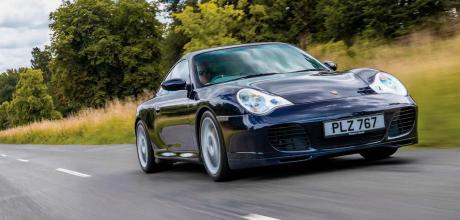2002 Porsche 911 Carrera 4S 996.2 converted to RWD
This side of a GT3 or Turbo, the Carrera 4S is widely considered the optimum 996. Paul Layte decided to refine the recipe. We track his car’s evolutionary progress to hot-yet-practical road-burner...
MOD SAGA
A Porsche 911 Carrera 4S 996.2 converted to RWD
Words Johnny Tipler
Photography Dan Sherwood
TRIED AND TESTED 996 CARRERA 4S RWD CONVERSION READER’S MODIFIED 911 CHANNELS ITS INNER GTS
By his own admission, Paul Layte is a serial Porsche meddler. Inside and out, there is almost nothing he hasn’t changed on his 996 Carrera 4S. He was turned on to the model during his time at university, when a fellow student was given a brandnew 996 C4S as a graduation present by his father (Tipler Junior received a second-hand Triumph Spitfire!). “He was German,” recalls the Hertfordshire native.
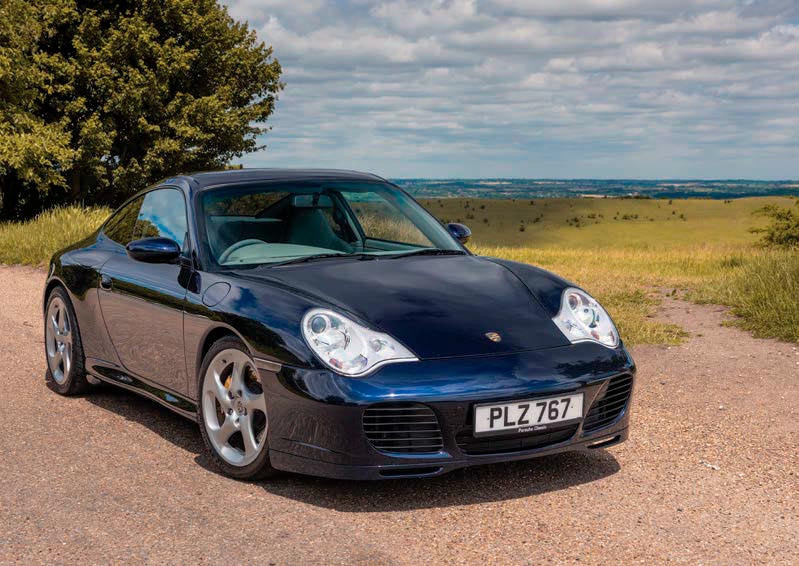
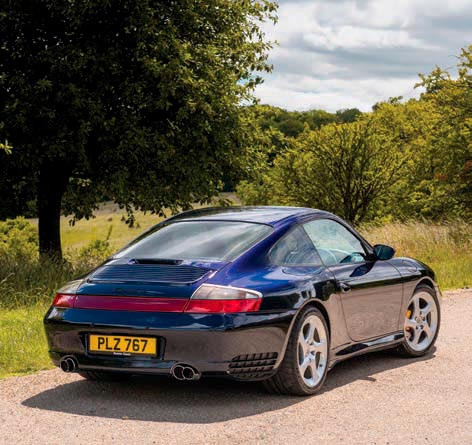
“His gifted 996 was left-hand drive because he was returning to his home country, but even with the steering wheel on the ‘wrong side’, such a lavish present was met with the immense jealousy of everybody else in our class.” Indeed, Paul was overawed by his associate’s car and vowed that one day, he would own a 996 C4S himself.
FINDING A 996 AT AN OFFICIAL PORSCHE CENTRE IS UNUSUAL MORE THAN TEN YEARS POST-PRODUCTION
A decade or so later, in 2018, he was perusing the Porsche used-car listings, as you do, when a tidy 996 C4S popped up in the classifieds listed by Porsche Centre Brooklands. The car was finished in Midnight Blue with Graphite Grey upholstery. This was perfect for Paul, who fancied anything other than a black interior. “It was a Saturday morning,” he tells us. “I contacted the dealership as soon as it opened and told the Centre’s salesman I wanted the car. On request, I registered a £500 deposit, promising to head over for collection a couple of hours later. Between me paying this sum and arriving at Brooklands, eight other people had contacted him to say they’d also take the car, if still available. I was told in no uncertain terms I’d need to commit there and then. Consequently, I took the Porsche for a spin, marvelled at the sound of its factory sports exhaust, delighted in the appointment of its sunroof, and bought the car as soon as I returned to the showroom.”
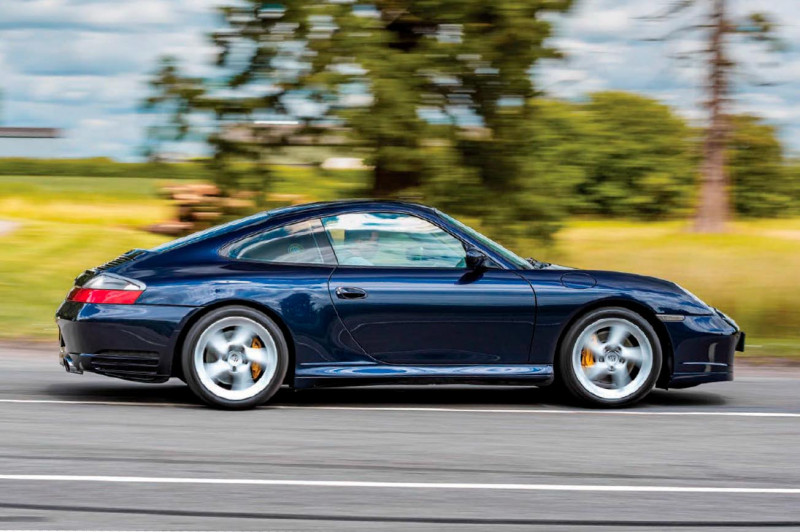
What’s the attraction? Sharing the stage with the rear-drive 996 Carrera, the all-wheel drive 996 C4S hit the scene in 2002, created using the wide-beam Turbo shell, as well as the all-wheel drive model’s brakes, wheels and suspension. A different engine means there’s no turbocharger (note the lack of distinguishing side air-scoops), but the C4S is no slouch, its 315bhp 3.6-litre flat-six enabling the sprint to 60mph from rest in five seconds, with top speed reaching a lofty 174mph. Finding a 996 at an Official Porsche Centre is unusual more than ten years post-production, but it transpired this was a two-owner 911. The first keeper held on to the car for three years, the second for eleven. With relatively low mileage, it was fair prospect as a trade-in for Brooklands. Even now, the car has only covered a total of 57,000 miles.
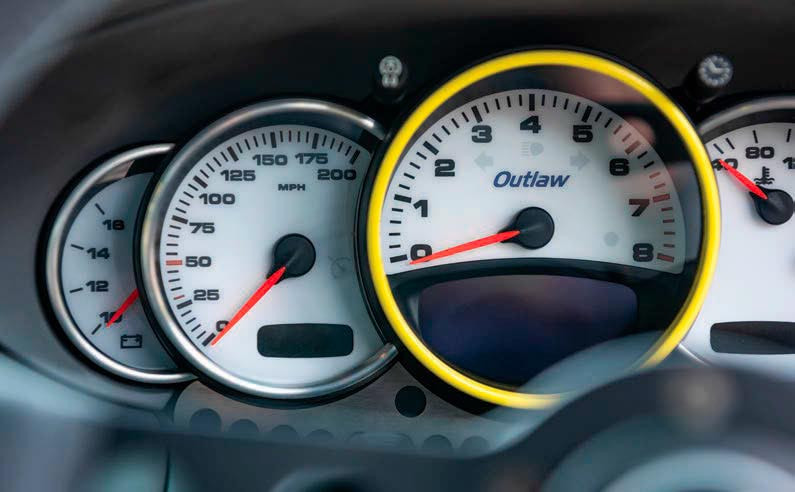
Paul’s penchant for tinkering targeted the relatively sophisticated 997 GTS (402bhp, 3.8-litres, rear-drive and wide body). In terms of character and style — as opposed to out-and-out specification — he set about imbuing his 996 with the spirit of the newer 911. “I kept reading how good the 997 GTS is wondered what it would take to make a 996 GTS.
Below 3.6-litre flat-six benefits from many upgrades, including an RPM Technik engine protection kit featuring a low-temperature thermostat and deep X71 oil sump
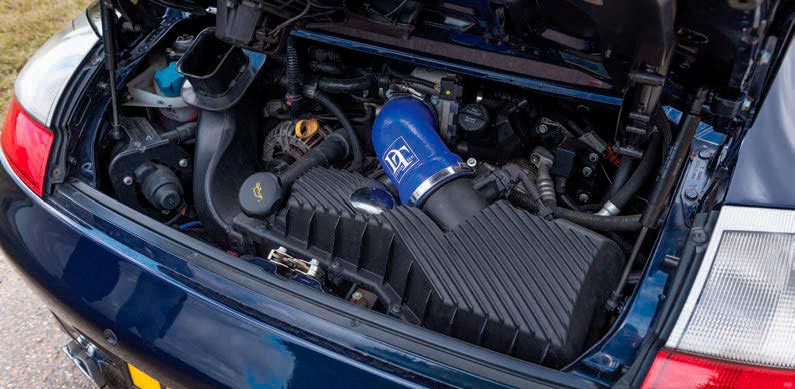
I reasoned the recipe would include Alcantara, even lower ride height, engine updates and suspension work. With this in mind, I decided to see I could knock something together that would be roughly what Porsche might have produced if it had been inclined to create a 996 GTS. Definitely not a 996 GT3, though — I would have bought a GT3 if I’d wanted one.” With two little children to consider, Paul needed two rear seats. A key step in the transformation trajectory of Paul’s C4S was to disconnect and remove the front driveline, partly in a bid to save weight, but also to obtain the sensitivity and feedback of the 996 Carrera’s unencumbered steering feel. The procedure sounds straightforward: the front driveline and propshaft are removed and capped off, thereby ensuring they don’t throw any traction control error codes. The car lost 75kg in the process, but the front ride height suddenly rose by 30mm. This is the point at which the major suspension work took off. It’s also when installation of a Quaife limited-slip differential (supplied and installed by Nine Excellence in Horley) took place.
MORE THAN A MATCH FOR MODERN 911s, CERTAINLY IN RESPECT OF HANDLING AND ON-ROAD ABILITY
We’ll be looking at the functionality of limitedslip differentials in next month’s issue of 911 & Porsche World. We’ll also outline differences between differential designs, including the torque-biasing Quaife ATB fitted to Paul’s Porsche.
BG Motorsport, the official Öhlins service centre at Silverstone, removed all the previous suspension kit and installed the a new Öhlins Road and Track package, featuring unique Dual Flow Valve (DFV) technology allowing the user to quickly change the stiffness of the shock absorber — turn the shock absorber’s golden knob clockwise to set it in race mode. This action changes all four areas in the damper: low and high-speed compression, plus rebound damping, thereby improving response times, bump absorption and increasing grip, meaning the host Porsche will be easier to balance on the edge of what its tyres can handle before losing traction. For a more sedate drive, simply set the dampers in road mode, still with quicker response time and increased grip, but offering a more relaxed and comfortable drive.
Losing the front driveline made a dramatic transformation to Paul’s 911. With other changes taken into consideration, it is 130kg lighter than standard and supposedly the lightest 996 C4S chassis tuning specialist, Center Gravity, has had on its weighing machine. “The biggest difference in the two-wheel drive conversion is the quality of the steering feedback, which went from being muted to suddenly very acute. The effect is as different as night and day.”
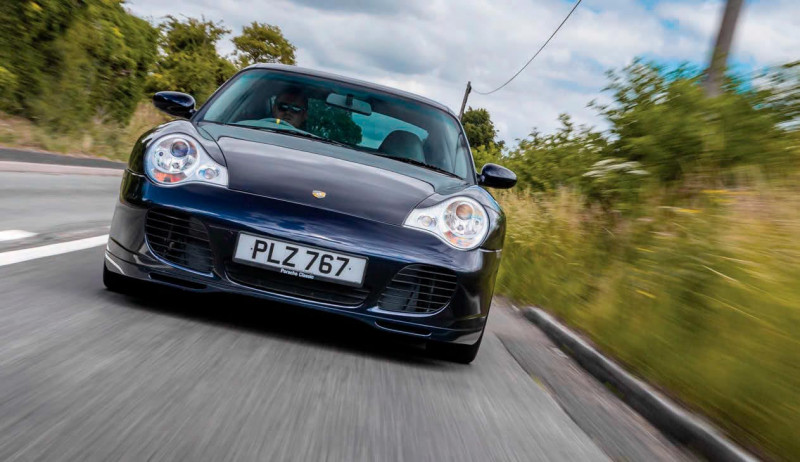
We can hardly call this Porsche a C4S any longer — it may be inspired by the 997 GTS, but Paul’s beautiful blue Porsche has become a 996 Carrera S, the sorely missing model in the 996 line-up. There’s no mistaking the C4S bodyshell, though. As well as a more purposeful stance (thanks to the revised suspension), the perimeters of the bodywork have been colour-coded Midnight Blue — the side-sills and front and rear lips, which are black plastic as standard, now blend with the rest of the car. Areas such as the leading edge of the rear wheel arch are prone to stone chips, which is why they’ve been treated to a flexible ceramic coating, applied by Max Protect in Kings Langley. As part of his Outlaw tendency, Paul has got rid of all C4S identity — the car simply wears a Carrera badge on its engine lid, where once it displayed the Carrera 4S script. I notice the Porsche Remote Park Assist buttons in the rear valence. “They do make reverse parking much easier,” he says. “It was a standard feature of the later cars.”
DEAD AND BURIED
There’s a lightweight lithium battery from Deadweight Industries mounted in the normal place. Costing an eyewatering £600, the unit only weighs 4.5kgs. Compare this to the standard battery, which is the wrong side of twenty-five kilos. “That was an easy twenty kilograms removed on top of the rear-drive conversion,” Paul smiles. “And this is the simple stuff. Removing the spare wheel, for instance, took the figure up to 100kg. You can go much further, obviously. Removing the rear seats would help, but this is something I won’t be doing.”
Predictably, the saga of the mods also included lowering the suspension, but it wasn’t a change completed without taking things a step too far. In fact, Paul has had a couple of goes at the suspension set-up, having lowered it too much on his first attempt, which compromised the ride for road use. “I went too aggressive, aiming for a track-oriented set-up. It was what’s designated as the X73 spring rate and ride height. It’s essentially GT3 territory, but delivered too much camber and toe-in. It wasn’t a nice drive on the motorway, where I noticed the car was a bit fidgety and prone to tramlining. The faster I went, the more nervous the car seemed to be, which is not what I want when I’m out with the family trying to enjoy a relaxed Sunday jaunt.” Having become reconciled to the fact his 996’s chassis was feeling too compromised for the road, he visited Center Gravity boss, Chris Franklin, and asked him to find a compromise suitable for track days, but also one exhibiting good road manners. A ‘cake and eat it’ scenario, if you will.
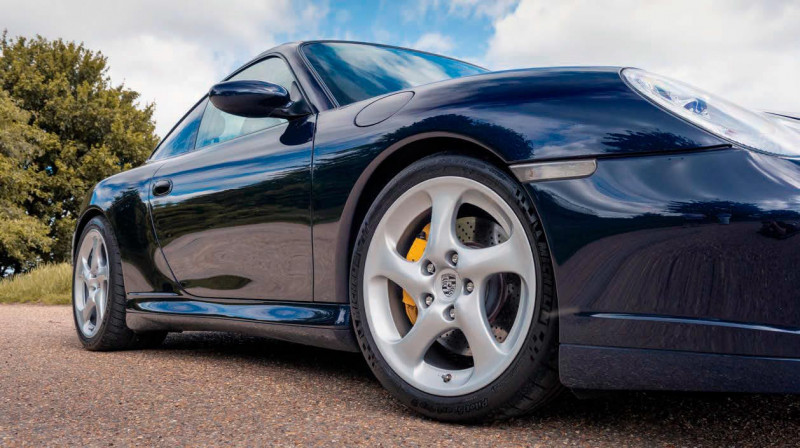
Custom springs were installed and the ride height was raised by 10mm (matching X74 specification). New camber-adjustable top mounts were fitted, but the standard anti-roll bars were retained. 7mm wheel spacers reside at the front of the car, while 15mm spacers are in use at the rear. The brakes, meanwhile, are standard C4S equipment, which is the same as the 996 Turbo’s anchors. For this reason, Paul didn’t feel the need to upgrade them, although the calipers were rebuilt and recoloured before being reinstated with new pads, discs and braided hoses. Goodwood track days are now not out of the question — with all its upgrades, there’s no doubt this highly personalised 996 can hold its own on the venue’s famously demanding circuit.
BREAK SILENCE
The engine emits a great sound, a sharp bark, even on tickover. Paul advises the noise is generated by the largely standard Porsche sports exhaust, although the pipework has been refurbished and is now kitted-out with 200-cell high-flow catalysts from independent Porsche tuner and parts retailer, FVD Brombacher. An uprated air filter has also been added to the mix, enabling the flat-six to ingest a little more air. The whole inlet and exhaust ensemble sounds much crisper than standard. There’s also an RPM Technik engine protection package featuring a low-temperature thermostat, though the headline act is the kit’s X71 sump, which is a deeper baffled part containing more lubricant to counter the effect of oil surge during hard cornering.
Just as fundamentally, this 996 makes use of RSS Performance engine mounts, also fitted by RPM Technik. The parts contribute greatly to the whole car’s torsional rigidity because the engine isn’t heaving around on its mounting points quite as much. The standard car’s hydraulic engine mounts provide a little give, allowing the powertrain to move independently from the chassis during acceleration and cornering, which, although the driver is hardly aware of the fact, upsets the car’s balance and handling behaviour. Available to order direct from independent Porsche parts supplier, Design 911, the RSS Tarmac Series employs special polyurethane bushes to minimise these forces, affording a firmer driving experience and optimal feedback without upsetting ride quality, nor causing knock sensor issues sometimes thrown up by the solid engine mounts used in competition cars.
Paul paints a positive picture of this modification, and I reckon I shan’t be far behind him. “The RSS engine mounts have made a huge improvement in terms of this 996’s on-road behaviour, simply because the engine is moving less in the engine bay. Now, when I travel fast around a corner and the suspension does its work, I don’t experience secondary movement from the flat-six. The drive is much more confidence-inspiring than standard, especially when powering through a fast sweeper. Available to buy for less than £400, I would recommend RSS mounts to any 996 owner.”
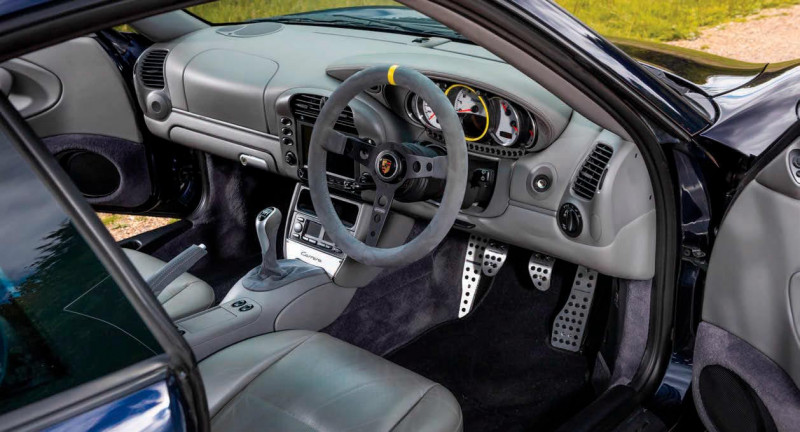
Above Changes are more pronounced in the cabin, where Paul has added an Alcantara-trimmed MOMO Prototipo steering wheel.
As described, the mounts are designed to minimise movement and are just slightly stiffer than standard, mirroring what Porsche did with the RS, where firmer engine mounts were used to stop the model’s engine acting as a pendulum. On the 996, especially if the car is making use of its factory mounts, which are likely past their serviceable life, moving to an engine mount like those from RSS, or the more competitively priced (and less firm) semi-solid products offered by Rohler (also available from Design 911), makes a world of difference to the host 911’s driving manners. A hard punch for modest spend.
WITH ITS FINELY-HONED SUSPENSION, IT FEELS REMARKABLY TIGHT IN CORNERS, NAILED DOWN, WITH SPOT-ON SHARP TURN-IN
LIGHT WORK
The 996 C4S was offered with solidspoke Twist wheels. Paul’s car rolls on genuine BBS-manufactured 996 Turbo wheels, similar in appearance, but featuring hollow spokes. “Apparently, they were an absolute nightmare to produce,” he laughs, noting BBS deleted the product from its catalogue a while back. “Each wheel is approximately 2.5kg lighter than a C4S Twist. There’s different valving, too. In fact, Porsche charges close to £30 per valve for these wheels — astonishingly expensive. On the plus side, as soon as I fitted the hollow-spoke eighteens, I could feel less rolling resistance than I did when the car was making use of the standard solidspoke wheels.” Tyres are Michelin Pilot Sport Cup 2 (225/40 ZR18 at the front and 275/30 ZR18 at the back).
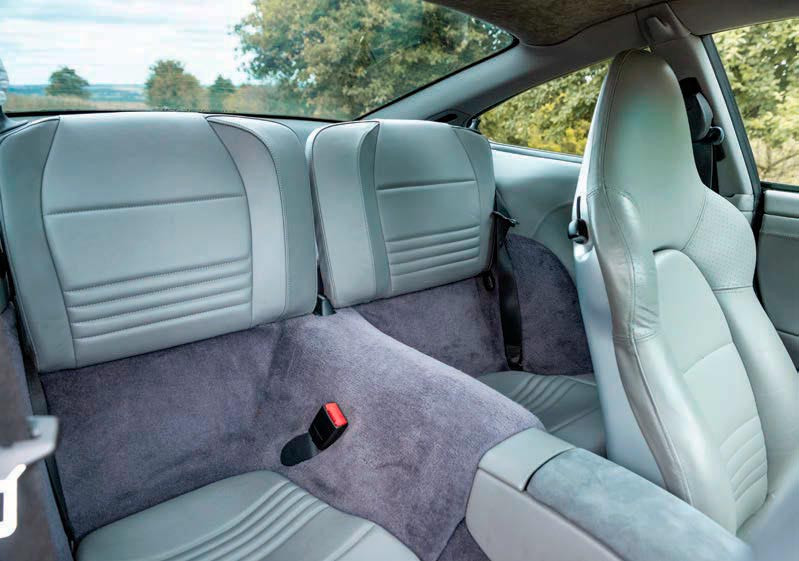
Let’s take a look inside the cabin. There’s a grey Alcantara headlining, which is standard, but Paul has had the gear gaiter and handbrake arm similarly clad. The centre console has been updated with a Porsche Classic Communication Management Plus hi-fi set, including DAB radio and integrated sat-nav. If you’re fed up with listening to Radio 2, Radio 4 and horrific-sounding AM broadcasting, this could be two grand well spent. Possibly.
The climate control panel has been moved down ahead of the gear lever, whilst the centre console cubbyhole contains a wireless adaptor box. The pedals are drilled aluminium and feature the Porsche logo, while the yellowedged rev-counter proclaims the car’s Outlaw leanings, accompanied by drilled metalwork surrounding the binnacle and matching the pedals. The steering wheel is a MOMO Prototipo trimmed in Alcantara with a yellow band. The work was carried out by Royal Steering Wheels in Aylesbury. “It provides just enough of the 911 GTS vibe,” Paul muses. “MOMO Prototipo is what Porsche used on its Cup cars back in the day. RPM Technik fitted the part for me, which requires an airbag delete. I wanted to be sure the switch didn’t throw an error code.”
PAUL’S CAR ROLLS ON GENUINE BBS-MANUFACTURED 996 TURBO WHEELS FEATURING HOLLOW SPOKES
He’s devoted a great deal of time and money to raising the specification of his 996, which is why I’m slightly surprised he hasn’t had a fresh intermediate main shaft (IMS) bearing fitted. “Like everybody, I’ve read all the horror stories online, but when you actually speak to specialists and hear what they say, the general consensus is that while a forsale 996 or 986 Boxster with an uprated or replaced IMS promotes peace of mind as an attractive selling point, the number of instances of part failure is actually very low.” When the Quaife limited-slipper was installed by Nine Excellence, the company also installed a new clutch and replaced the engine’s rear main seal (another M96/ M97 bugbear, though nothing to worry about), but didn’t put IMS replacement on the list of must-haves.
“Nine Excellence’s technicians confirmed there was no play in the bearing and no oil leak. If it ain’t broke, don’t fix it! It’s a near twenty-year-old 996 — if the IMS was going to fail, it would have surely done so by now.” Incidentally, if you do decide to change the IMS bearing on your M96/M97- equipped 911 or same-age Boxster/ Cayman, keep in mind many replacement sets have a shelf life, therefore they become a service item, meaning you’ll need to repeat the job every seven years. “The original bearing was intended to last the life of the car, so you don’t want to change it for one you’re going to be swapping every few years,” Paul advises. “In the grand scheme of 911 ownership, the 996 is supposed to present relatively low-cost. The last thing you want is to be spending an additional thousand quid every seven years. If my car’s IMS unexpectedly failed, however, I’d invest in a Hartech oversized engine rebuild, packing 3.9-litres of displacement, good for 350bhp and delivering more torque, getting close to GT3 territory and offering rock-solid reliability.” We road-tested Hartech’s 4.1-litre oversized M97 engine development in last month’s issue of 911 & Porsche World. Suffice to say, we wholeheartedly appreciate the appeal.
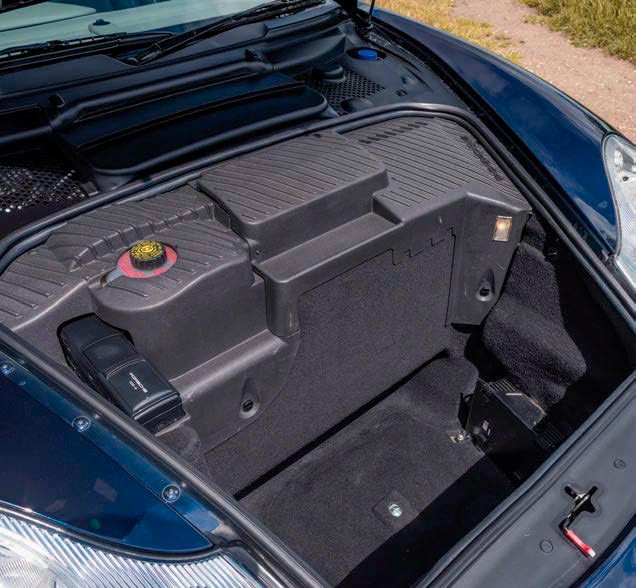
We need to give this modified 996 a go. I shift the seat to accommodate my favoured driving style and we set the satnav for nearby Ashridge and its heathy upland backroads. Plenty of scope up here for some entertaining cornering. Broadly, the controls are very familiar. My first impression is that the Prototipo wheel feels nice to handle and I noted a GT3 short-shift gear lever, which Paul confirms was optioned by the car’s original owner. Throttle response is right there on cue and I’m immediately feeling the sensitivity of the steering, blessed as it is without the frontwheel drive aspect.
Comparing the standard Carrera and C4S, one is a wee bit flighty, the other stern and taciturn. The livelier Carrera’s darting quality evokes a certain satisfaction at its fluency, while the C4S says, ‘hold on buddy, I’ll take over here and do this for you’. You’re still at the controls, but it’s as if you’ve got someone else taking charge of proceedings. Fair enough, but it’s less thrilling than the two-wheel drive car, though rewarding in its own competent way.
While it lacks the sprightlier character of the Carrera, the C4S feels more planted. This is an appraisal of the standard cars, though. Paul’s 996 is completely different, of course, behaving like a broader Carrera, though with its finelyhoned suspension and those tauter engine mounts, it feels remarkably tight in corners, nailed down, with absolutely spot-on sharp turn-in. Acceleration is mighty, especially when confronted with a shall-I-shan’t-I overtaking proposition. Conversely, those Turbo-derived brakes are efficient enough, but they lack feedback. Sure, you feel the car slowing down, but you don’t get a sense of pushback from the pedal, just blunt resistance. Nevertheless, this 996 is extremely efficient in the way it covers ground and how dynamically responsive everything is. It is, I have to say, a much nicer drive than newer 911s, which, to my taste, provide less feedback and feel the more recent they get. Has Paul emulated the 997 GTS, though? Up to a point, although that particular 911 is somewhat quicker and has the benefit of the 997’s hewn-from-stone character.
Paul has sound council for would-be 996 owners. For a start, he recommends updating and upgrading the in-car entertainment, just to make for a more family-friendly 911. “It’s an absolute nobrainer,” he stresses. “You can listen to all the stations, your own playlist, make handsfree calls and the sat-nav is bang up to date. To any 911 & Porsche World reader considering 996 ownership, budget a few choice modifications into the purchase price. Uprated engine mounts are a great start, especially if the car’s standard mounts haven’t been replaced before. Additionally, make sure the suspension is fully up to scratch.
If not, replace the arms and re-bush wherever possible. I would definitely try to get hold of these hollow-spoke wheels or rims with similar weight, though the titanium lug nuts my car uses aren’t much lighter than standard aluminium parts when compared side-by-side.
The titanium parts are also quite a bit more expensive, plus the metal is softer, meaning you can easily ruin the thread if you’re not careful. I probably wouldn’t buy them again.”
As someone who’s been over his entire car, tweaking this and that, Paul has done a great job of embellishing and customising his 996. The carefully selected upgrades mean his is a Porsche more than a match for modern 911s, certainly in respect of handling and on road ability. It’s not unique in having been transformed from an all-wheel drive 996 into one pushing only from the rear, but the execution of the car as a whole is highly individualistic. Perhaps the point is how it reflects something of its owner’s personality. In our own way, we’d all like our Porsches to do the same.
Above The 996 Carrera 4S is one of the Porsche scene’s best buys, presenting prospective owners with a huge amount of 911 for their money.
Above Hollowspoke wheels are a ‘Twists’ are a Turbo trademark, but look very much like the standard 996 Carrera 4S wheels to the casual observer Right Paul has removed all mention of the four-wheel drive system, opting for simple Carrera script Bottom The frontdrive system might be missing, but luggage area remains as compromised as it. Above and below Changed to this 996 have delivered a dramatic impact on the driving experience, but go under the radar due to subtlety of execution.
Below Only the lack of wing, air intakes on the rear quarters and the addition of a reflector strip between the back lights separate the look of the 996 Turbo and Carrera 4S.
Above Chunky ‘tombstones’ are a supremely comfortable seat and hold the driver firmly in place when the car is taking on corners at high speed.


